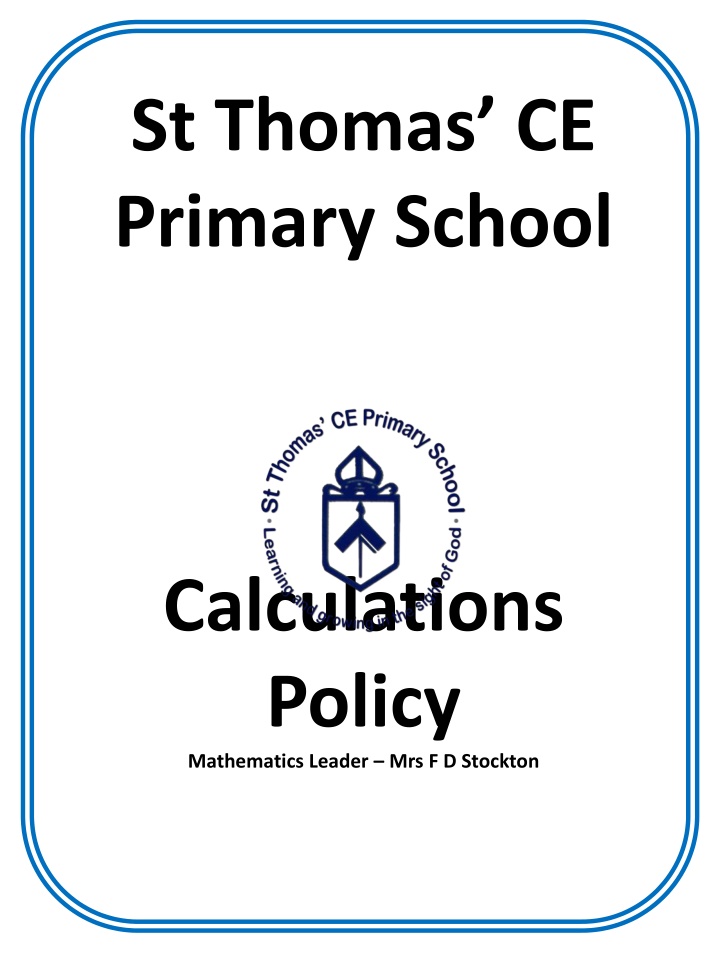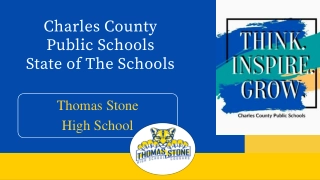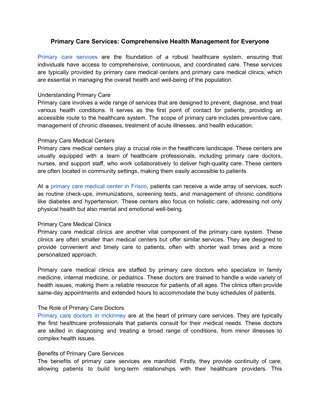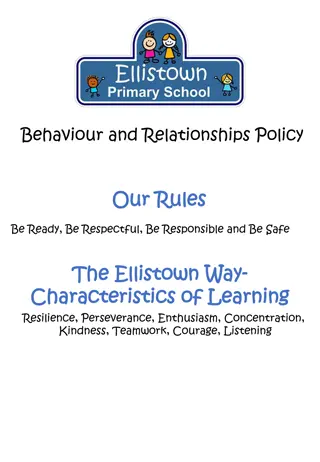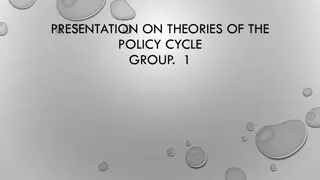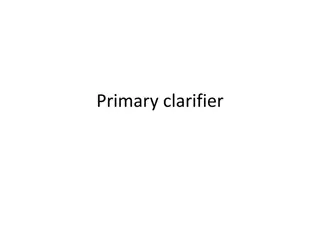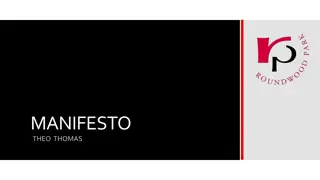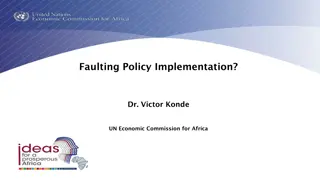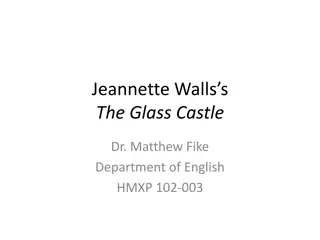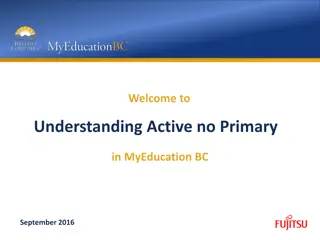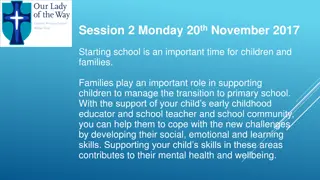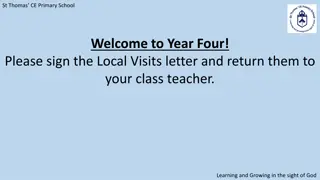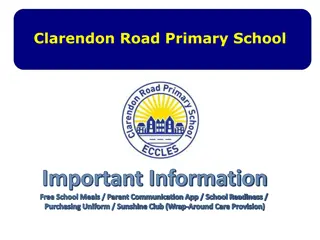St. Thomas CE Primary School Calculations Policy
This policy outlines key mental and pencil-and-paper procedures to be taught at St. Thomas CE Primary School, emphasizing the importance of mental calculation alongside written methods. It aims to ensure consistency and progression in mathematics education, encouraging children to select efficient methods for various tasks. The policy covers strategies for mental and written calculations, highlighting the need for understanding mathematical principles and addressing challenges in teaching written methods effectively.
Download Presentation

Please find below an Image/Link to download the presentation.
The content on the website is provided AS IS for your information and personal use only. It may not be sold, licensed, or shared on other websites without obtaining consent from the author.If you encounter any issues during the download, it is possible that the publisher has removed the file from their server.
You are allowed to download the files provided on this website for personal or commercial use, subject to the condition that they are used lawfully. All files are the property of their respective owners.
The content on the website is provided AS IS for your information and personal use only. It may not be sold, licensed, or shared on other websites without obtaining consent from the author.
E N D
Presentation Transcript
St Thomas CE Primary School Calculations Policy Mathematics Leader Mrs F D Stockton
St Thomas CE Primary School Maths Calculation Policy This policy contains the key mental and pencil and paper procedures that are to be taught throughout the school. It has been written to ensure consistency and progression throughout the school. Although the main focus of this policy is on pencil and paper procedures, it is important to recognise that the ability to calculate mentally lies at the heart of numeracy. Mental calculation is not at the exclusion of written recording and should be seen as complementary to and not separate from it. In every written method there should be an element of mental processing. Written recordings help the children to clarify their thinking and supports and extends the development of more fluent and sophisticated mental strategies. Although each method will be taught in the year group specified, teachers should use their judgement to decide on the stage of progression of the child and they should differentiate appropriately. The long term aim for the children is to be able to select an efficient method of their choice that is appropriate for a given task. They should do this by asking themselves; Can I do this in my head? Can I do this in my head using jottings or drawings? Do I need to use a written method?
WRITTEN CALCULATION The aim for written calculations is different from the aim for mental calculations. With mental work, the aim is to teach children a repertoire of strategies from which to select. With written calculations the ultimate aim is proficiency in a compact method for each operation with one clear progression route taught for each. Mental calculation Strategies for mental calculation are introduced from Y1 or Y2 to Y3 and developed further in Y4, Y5 and Y6. All children, apart from those with significant special educational needs, should be introduced to the full range of mental calculation strategies when they have the necessary pre-requisite skills. Children with significant special needs should learn a narrow range of strategies which are generally applicable. Written calculation Building on the mental strategies they have used so that they can understand the processes involved, children need first to be taught to record their methods in an expanded form. When ready - and this is dependent on teachers professional judgement - they are taught how to refine the recording to make it more compact. Challenges to teachers Ensuring that recall skills are established first so children can concentrate on a written method without reverting to first principles Making sure that, once written methods are introduced, children continue to look out for and recognise the special cases that can be done mentally; Catering for children who progress at different rates; some may grasp a compact method of calculation while others may never do so without considerable help; Catering for children who can carry out some standard methods successfully, e.g. for addition, but not subtraction;
Recognising that children tend to forget a standard method if they have no understanding of what they are doing. Often the compactness of a vertical method conceals how mathematical principles are applied, e.g. children may use place value when working mentally, but be confused in written work because they do not understand how place value relates to carrying . There can be long-lasting problems for those taught compact, vertical methods before they understand what they are doing. Simply correcting children s errors may help in the short-term, but not permanently. Misunderstandings and misconceptions need to be analysed. Children need to understand why a particular method works rather than simply following a set of rules. They can then fall back to a simpler method if uncertain, or to check their answer. NOTE: In the attached guidance, suggestions are given as to when written methods and particular layouts should be introduced. However, the most importance thing to consider, rather than age, is whether children have the necessary pre-requisite skills.
ADDITION Children are taught to understand addition as combining two sets and counting on. A progression from R to Y6 Working practically or drawing a picture helps children to visualise the problem. 2 + 3 = + At a party, I eat 5 cakes and my friend eats 3. How many cakes did we eat altogether? https://encrypted-tbn0.gstatic.com/images?q=tbn:ANd9GcRJClVhUOC24x-JQpb1BmB9lreDllrjqR0bDE-MXMWX6YMb7iQ8sw https://encrypted-tbn0.gstatic.com/images?q=tbn:ANd9GcRJClVhUOC24x-JQpb1BmB9lreDllrjqR0bDE-MXMWX6YMb7iQ8sw https://encrypted-tbn0.gstatic.com/images?q=tbn:ANd9GcRJClVhUOC24x-JQpb1BmB9lreDllrjqR0bDE-MXMWX6YMb7iQ8sw https://encrypted-tbn0.gstatic.com/images?q=tbn:ANd9GcRJClVhUOC24x-JQpb1BmB9lreDllrjqR0bDE-MXMWX6YMb7iQ8sw https://encrypted-tbn0.gstatic.com/images?q=tbn:ANd9GcRJClVhUOC24x-JQpb1BmB9lreDllrjqR0bDE-MXMWX6YMb7iQ8sw https://encrypted-tbn0.gstatic.com/images?q=tbn:ANd9GcRJClVhUOC24x-JQpb1BmB9lreDllrjqR0bDE-MXMWX6YMb7iQ8sw https://encrypted-tbn0.gstatic.com/images?q=tbn:ANd9GcRJClVhUOC24x-JQpb1BmB9lreDllrjqR0bDE-MXMWX6YMb7iQ8sw https://encrypted-tbn0.gstatic.com/images?q=tbn:ANd9GcRJClVhUOC24x-JQpb1BmB9lreDllrjqR0bDE-MXMWX6YMb7iQ8sw 7 people are on the bus. 4 more got on at the next stop. How many people are on the bus now? Children are encouraged to progress towards using dots or marks.
Counting forwards NUMBERLINES ARE VERY IMPORTANT! 8 + 3 +1 +1 +1 Children can count up using an empty number line. This is a really good way for them to record the steps they have taken. 8 9 10 11 What is 32 + 24? +10 +10 +1 +1 +1 +1 They are encouraged to use the most efficient method to solve a given calculation, therefore you may see children putting the largest number first or partitioning a number into tens and ones. 32 42 52 53 54 55 56 56 + 41 = + 5 6 4 1 + + 6 + 1 50 40 An expanded approach is introduced when children are secure with the mental calculation methods. 90 7 + 9 7 366 + 172 366 Initially children are taught to add the most significant digit first (i.e. Working from left to right). +172 400 130 8 538
Children then progress to working from the least significant digit first, i.e. units, but still need to read the numbers as 6 + 7, 40 + 80, 500 + 400, to secure full understanding of the approach used. 546 +487 13 120 900 1033 546 +487 1033 The compact method is used when children are confidently using the expanded approach. The train leaves at 2 o clock in the afternoon and arrives at 5.30pm. How long is the journey? Children are encouraged to use a blank number line to solve money, time, decimal and other calculations. +3h +30m 2pm 5pm 5:30pm The journey takes 3 hours 30 minutes 23.7 + 4.4 +4 +0.3 +0.1 23.7 27.7 28 28.1
SUBTRACTION Children are taught to understand subtraction as taking away (counting back) and finding the difference (counting up). A progression from R to Y6 5 - 2 = Drawing a picture helps children to visualise the problem. I had five balloons. Two burst. How many did I have left? Take away A teddy bear costs 5 and a doll costs 2. How much more does the bear cost? Find the difference Lisa has 5 felt tip pens and Tim has 2. How many more does Lisa have? Children are encouraged to progress towards using dots or marks.
There are 28 children in the class, 5 have sandwiches for lunch. How many have a hot dinner? 28 5 = 23 +10 NUMBERLINES ARE VERY IMPORTANT! Children can count up or back using an empty number line. This is a really good way for them to record the steps they have taken. +5 +8 0 5 10 20 28 5 + 10 + 8 The baker makes 54 loaves and sells 28. How many has he left? 54 28 - 4 - 4 - 20 26 30 34 54 26 loaves are left Children are encouraged to use the most efficient method to solve a given calculation, therefore you may see children using a blank number line to solve money, time, decimal and other types of calculations. The train leaves at 12.18 and arrives at 15.46. How long is the journey? +16 min + 3h +12 min 12.18 12.30 15.30 15.46 The journey takes 3h 28min 6.1 2.4 +0.6 + 3.1 2.4 3 6.1
This expanded approach is introduced when children are confident with the mental calculation methods. 87 35 = 8 7 80 7 - 3 5 30 5 - 50 2 5 2 This is used to develop a more compact method. The word and is used to show what the numbers are partitioned into and is preferred to + so as not to confuse addition with subtraction. 563 248 500 and 60 and 3 Exchange 60 into 50 - 200 and 40 and 8 and 10 500 and 50 and 13 - 200 and 40 and 8 300 and 10 and 5 643 358 Numbers are exchanged to enable the children to complete the process. 600 and 40 and 3 Exchange 40 into 30 -300 and 50 and 8 and 10 600 and 30 and 13 Exchange 600 into -300 and 50 and 8 500 and 100 The compact method hides the understanding and can confuse children I know I need to cross out but which numbers? They may not reach this until they are in KS3. 500 and 130 and 13 -300 and 50 and 8 200 and 80 and 5 1 3 5 1 6 4 3 - 3 5 8 2 8 5
MULTIPLICATION Children are taught to understand multiplication as repeated addition. A progression from R to Y6 0, 1, 2, 3, 4, 5, 6, 7, 8, 9, 10 Children are introduced to multiplication by counting on and back in equal steps of ones, twos, fives and tens. 0, 2, 4, 6, 8, 10, 12, 14, 16, 18, 20 2 X 4 Each child has two feet. How many feet do four children have? Working practically or drawing a picture helps children to visualise the problem. 2 + 2 + 2 + 2 6 x 3 There are 6 eggs in a box. How many eggs in 3 boxes? Dots or tally marks are often drawn in groups. This shows 3 groups of 6. 6 + 6 + 6 4 x 4 There are 4 cats. Each cat has 4 kittens. How many kittens are there altogether? +4 +4 Children can count on in equal steps using an empty number line. This shows 4 jumps of 4. +4 +4 0 4 8 12 16
Drawing an array (3 rows of 4 or 4 rows of 3) gives children an image of the answer. It also helps to develop the understanding that 4 x 3 has the same value as 3 x 4. 4 x 3 3 x 4 14 x 7 = With bigger numbers, it is inefficient to do lots of jumps on a number line or to draw an array. 10 4 7 GRID METHOD Children will start to formally multiply using the structure often called the Grid Method . When calculating 14 x 7, 14 is partitioned into 10 and 4, and each of these is multiplied by 7. The two answers are then added together. 10 4 70 + 28 = 98 70 28 7 17 x 14 = 10 7 The idea of splitting a number into its parts, helps children to understand the process of multiplication. 100 + 70 + 40 + 28 = 238 10 100 70 4 40 28 This method is also used with larger numbers. Again partition the numbers and multiply each part. Add the numbers together. 268 x 53 = 200 60 8 50 10 000 3000 400 Children will need a secure recall of times tables and facts to successfully use the grid method of multiplication. 3 600 180 24 10 000 + 3000 + 400 + 600 + 180 + 24 = 14 204
When children are able to successfully multiply TU by TU using the grid method, they should be taught the column method. 37 x 12 x 14 2 x 7 60 2 x 30 70 10 x 7 300 10 x 30 444 The column method builds on from the grid method. Children will continue to extend their multiplication sums using an expanded column method. 1 3 7 x 1 2 7 4 3 7 0 4 4 4 1 Children will extend use of written methods and may be taught the compact methods if the Class Teacher feels that children are ready for this stage. 1
DIVISION Children are taught to understand addition as sharing, grouping and chunking. A progression from R to Y6 There are 12 sweets and 2 children. They share the sweets equally. How many sweets does each child have? Sharing is a skill children come to school with. One for me, one for you is repeated subtraction of one. Sharing between two Working practically or drawing a picture helps children to visualise the problem. In this example, children share the 12 sweets between the two children until there are none left. Each child has 6 sweets Grouping in threes There are 12 sweets and each party bag needs three sweets. How many party bags can be made? Children progress to removing groups of a number. In this example, children put groups of three sweets into the party bags until they have no sweets left. There are 4 party bags
12 4 = Dots or tally marks are often drawn in groups. This shows 3 groups of 4. 4 apples are packed in a basket. How many baskets can you fill with 12 apples? Children can count on in equal steps using an empty number line to work out how many groups of 7 there are in 28. This shows you need 4 jumps of 7 to reach 28. 28 7 = A chew bar costs 7p. How many can I buy with 28p? +7 +7 +7 +7 0 7 14 21 28 63 children need to be seated in groups of 4. How many tables will be needed to seat all the children? When numbers get bigger, it is inefficient to do lots of small jumps on a number line. Children begin to jump in chunks of the number they are dividing by. In this example, chunks of 4 are used. A jump of 10 groups of 4 takes you to 40. Then you need another 5 groups of 4 to reach 60, leaving a remainder of 3. 63 4 = 15 r 3 10 x 4 5 x 4 rem 3 0 40 60 63 16 tables will be needed to seat all the children, one will only have 3 seats.
Some teachers refer to this next method as the bus stop method! Here, we look at how many 4 s go into 6 (technically we have to remember this is actually 60, not 6. The initial answer is 1, remainder 2. The 2 is then put in front of the digit 3. How many 4 s go into 23? Answer 5 r 3. 63 4 = 15 r 3 1 5 r3 2 4 6 3 63 4 = 15 r 3 Children will start formal calculations by using the chunking method of division. The chunks of 4 are subtracted (10 groups of 4, 5 groups of 4) until no more chunks remain. This example shows 15 groups of 4 and a remainder of 3. 4 6 4 3 0 10 x 4 2 2 3 0 5 x 4 3 412 7 = 58 r 6 This method is also used with larger numbers. Children need to have a secure knowledge of tables facts and be able to derive associated facts. 7 4 1 2 - 3 5 0 6 2 - 5 6 6 50 x 7 8 x 7 The chunking method is particularly useful for dividing by 2 digit, e.g.. 462 17.
Children will find remainders as whole numbers first, then as a fraction of the whole and then as a decimal when they move to the more compact (bus stop) method outlined earlier. Children will learn their multiplication facts and understand that multiplication and division are inverse operations if you know your times tables, you know your division tables. Things I know about 7: Children will might start by generating facts they know about 7. 7 x 1 = 7 7 x 10 = 70 7 x 2 = 14 7 x 20 = 140 7 x 5 = 35 7 x 50 = 350 It is important that the children try not to write out the whole table but just significant multiples.
